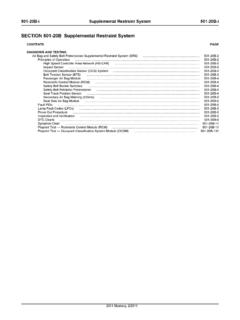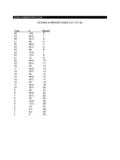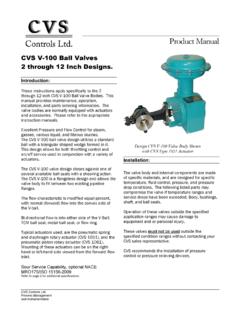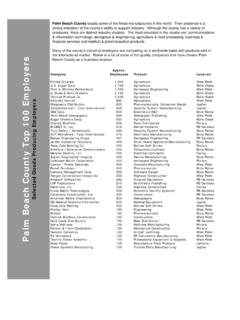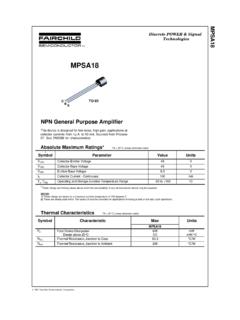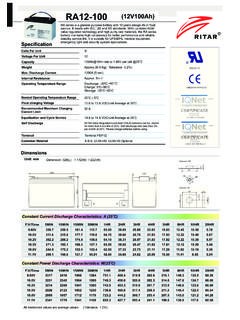Transcription of SECTION 100-04 Noise, Vibration and Harshness
1 SECTION 100-04 Noise, Vibration and HarshnessCONTENTSPAGEDIAGNOSIS AND TESTINGN oise, Vibration and Harshness (NVH) .. 100-04 -2 Diagnostic Theory .. 100-04 -2 Diagnostic Procedure Overview .. 100-04 -3 Tools and Techniques .. 100-04 -3 Write-Up Job Aid .. 100-04 -51: Customer Interview .. 100-04 -62: Pre-Drive Check .. 100-04 -63: Preparing for the Road Test .. 100-04 -64: Verify the Customer Concern .. 100-04 -75: Road Test .. 100-04 -7 Slow Acceleration Test .. 100-04 -7 Heavy Acceleration Test .. 100-04 -7 Neutral Coast Down Speed Test .. 100-04 -8 Downshift Speed Test .. 100-04 -8 Steering Input Test .. 100-04 -8 Brake Test .. 100-04 -8 Road Test Over Bumps .. 100-04 -8 Neutral Engine Run-Up (NERU) Test .. 100-04 -8 Drive Engine Run-Up (DERU) Load Test .. 100-04 -8 Engine Accessory Test .. 100-04 -9 Vehicle Cold Soak Procedure.
2 100-04 -9 Classify NVH Symptom .. 100-04 -9 Noise Symptoms .. 100-04 -9 Vibration Symptoms .. 100-04 -10 Order of Vibration .. 100-04 -10 Relationship of Vibration Frequency to Order of Vibration .. 100-04 -10 Frequency Calculations .. 100-04 -10 Calculating Tire and Wheel Frequency .. 100-04 -10 Calculating Driveshaft Frequency .. 100-04 -11 Calculating Engine Frequency .. 100-04 -11 Calculating Engine Accessory Frequency .. 100-04 -11 Calculating Engine Firing Frequency .. 100-04 -11 Frequency and RPM Calculations Worksheet .. 100-04 -12 Harshness Symptoms .. 100-04 -12 NVH Symptom Chart Categories .. 100-04 -13 Vehicle-Speed Related Vibrations .. 100-04 -13 Symptom Chart Tire-Speed Related Vibrations .. 100-04 -13 Symptom Chart Driveshaft-Speed Related Vibrations .. 100-04 -13 Symptom Chart Engine-Speed Related Vibrations.
3 100-04 -14 Symptom Chart Noise, Air Leaks or Water Leaks .. 100-04 -14 Symptom Chart Harshness .. 100-04 -15100-04-iNoise, Vibration and Harshness100-04-i2011 Mustang, 2/2011 DIAGNOSIS AND TESTINGN oise, Vibration and Harshness (NVH)Special Tool(s) electronic Vibration analyzer (EVA)100-F027 (014-00344) or equivalentEngineEAR107-R2100 or equivalentEngineEAR/ChassisEAR107-R2102 or equivalentMastertech Series MTS 4000 Driveline Balance and NVH analyzer (Vetronix)257-00018 or equivalentSqueak and Rattle Repair Kit164-R4900 Ultrasonic Leak Detector134-R0135 or equivalentDiagnostic TheoryThe shortest route to an accurate diagnosis results from: system knowledge, including comparison with a known good system. system history, including repair history and usage , Vibration and Harshness100-04-22011 Mustang, 2/2011 condition history, especially any relationship to repairs or sudden change.
4 Knowledge of possible sources. using a systematic diagnostic method that divides the system into related diagnosis and correction of NVH symptoms requires: a road or system test to determine the exact nature of the symptom. an analysis of the possible causes. testing to verify the cause. repairing any symptoms found. a road test or system test to make sure the cause has been corrected or brought back to within an acceptable Procedure OverviewQualifying the symptom by the particular sensation present can help narrow down the cause. Always use the "symptom" to "system" to "component" to"cause" diagnosis technique. This diagnostic method divides the problem into related areas to correct the customer concern. Verify the "symptom". Determine which "system(s)" can cause the "symptom" using the diagnostic tools described in this SECTION .
5 After determining the possible "system(s)", refer to the appropriate SECTION in this manual to identify the worn or damaged "components". After identifying the "components", identify the "cause" of the and TechniquesThe diagnostic tools allow for a systematic collection of information that is necessary to accurately diagnose and repair NVH problems. Remember that thevibrating source component (originator) may only generate a small Vibration . This small Vibration can in turn cause a larger Vibration /noise to emanate fromanother receiving component (reactor), due to contact with other components (transfer path). For the best results, carry out the test as drive the vehicle with the Vibration sensor inside the the sensor in the vehicle according to feel. If the condition is felt through the steering wheel, the source is most likely in the front of the vehicle.
6 A Vibration that is felt in the seat or floor only will most likely be found in the driveline, drive axle or rear wheels and the readings. Also note when the condition begins, when it reaches maximum intensity and if it tends to diminish above/below a certain speed. If a Vibration symptom is vehicle speed related, the tire and wheel rpm/frequency and driveshaft frequency should be calculated. If a Vibration symptom is engine speed related, the engine, engine accessory and engine firing frequencies should be calculated. Frequencies with an amplitude reading of Gs or less are barely perceptible NVH levels. No corrective action is the Vibration sensor on or near the suspect area outside the the road test, driving the vehicle at the speed the symptom occurs and take another the readings. A match in frequency indicates the problem component or area.
7 An unmatched test could indicate the symptom is caused by the engine, torque converter or engine accessory. Use the diagnostic tools in the rpmmode and check if symptom is rpm following diagnostic tools and techniques can be used separately or in conjunction with each other to aid in the diagnosis of NVH symptoms. They arelisted in order of preference for ease in their use for locating these analyzer (Vetronix)The Mastertech Series MTS 4000 Driveline Balance and NVH analyzer (Vetronix) and the MTS 4100 NVH analyzers are tools to aid in the identificationand isolation of a noise, Vibration or Harshness symptom in a vehicle. They measure noise and Vibration data and compare it with data obtained from thevehicle's PCM as well as vehicle variants that were entered by the user such as pulley size, axle ratio and tire size in order to provide possible sources.
8 TheMastertech Series MTS 4000 Driveline Balance and NVH analyzer (Vetronix) and the MTS 4100 have the following characteristics: Interface with the vehicle's computer system Support and store Vibration data input from 1 or 2 accelerometers Support and store noise data input from 2 microphones Provide a photo-tachometer for operation of the driveshaft balancing function Provide a strobe output capable of driving a standard timing light Contain a real-time clock circuit that provides time and date information which is used for tagging test data Have the capability to print to an external printer and interface with a PC Can be powered from a variety of power sources: cigarette lighter, AC power or the internal battery packThe Mastertech Series MTS 4000 Driveline Balance and NVH analyzer (Vetronix) and the MTS 4100 NVH analyzers have 4 main operating modes.
9 Thefirst is for Vibration diagnosis. This mode measures data from 1 or 2 accelerometers simultaneously while obtaining data from the vehicle. Then it carries outa frequency analysis on the accelerometer information and compares the Vibration frequencies with the frequencies associated with various rotating100-04-3 Noise, Vibration and Harshness100-04-3 DIAGNOSIS AND TESTING (Continued)2011 Mustang, 2/2011components within the vehicle. The data can be presented in 4 different display modes: principle component, bar chart, frequency spectrum or waterfall. Alldisplay mode formats contain the same common elements, such as second is for noise diagnosis. This mode measures noise from 1 or 2 microphones simultaneously. All noise measurements are in decibels (dBs). Allfrequency bands used for noise measurements are the same as for the Vibration measurements, up to 1,000 third is driveshaft balancing.
10 Driveshaft balancing is done using 1 or 2 accelerometers and a photo-tachometer. The accelerometers measure thevibration at both ends of the driveshaft, while the photo-tachometer measures the rotation speed and position reference. Refer to SECTION fourth is the strobe. A strobe or standard timing light can be connected to an analyzer , to provide a means for measuring rotation speed. The strobefunction is used for isolating the source of a Vibration analyzer (EVA)The electronic Vibration analyzer (EVA) is a hand-held electronic scan tool which will assist in locating the source of unacceptable vibrations. Thevibration sensor can be remotely mounted anywhere in the vehicle for testing purposes. The unit displays the 3 most common Vibration frequencies and theircorresponding amplitudes simultaneously.




